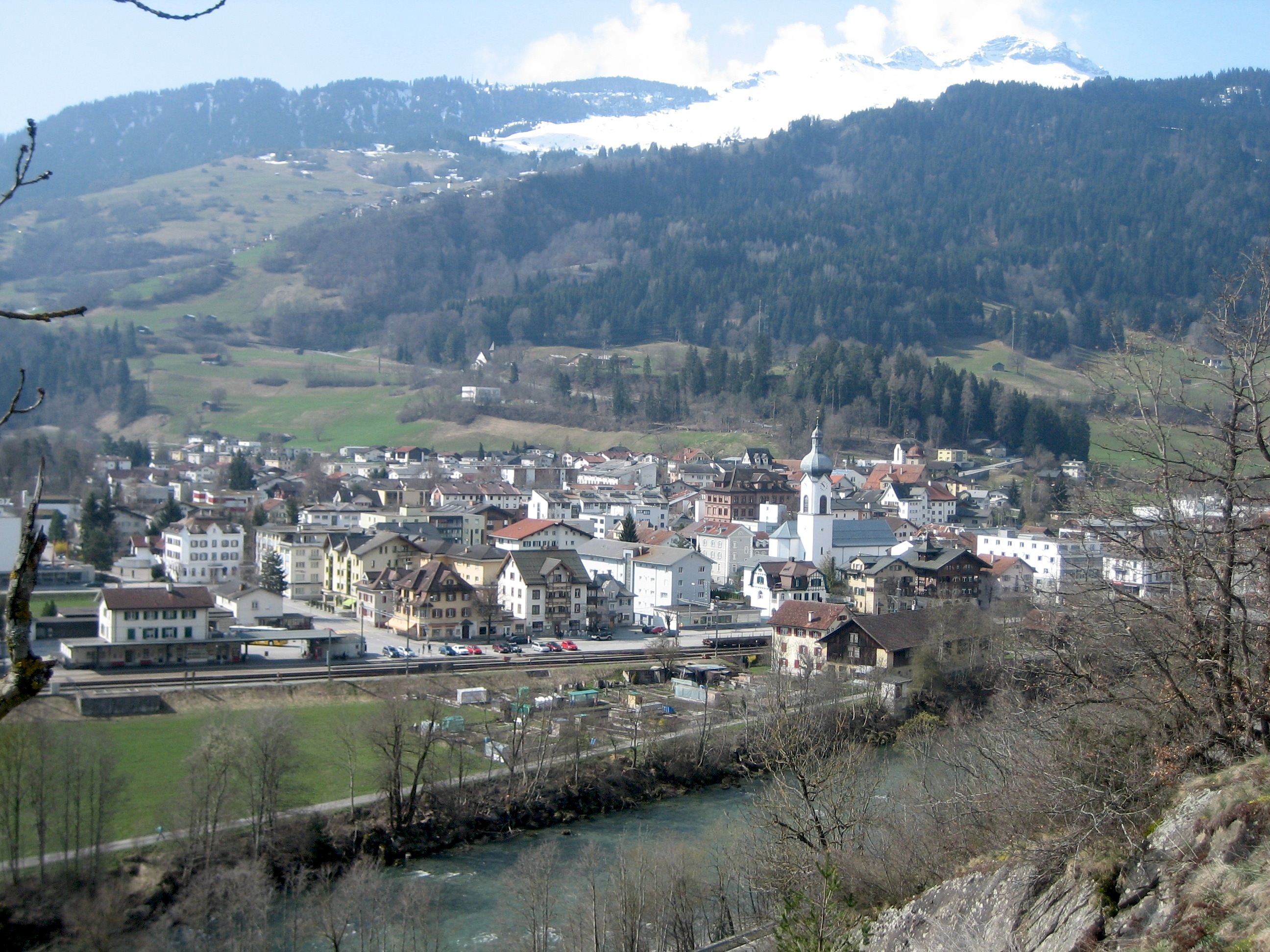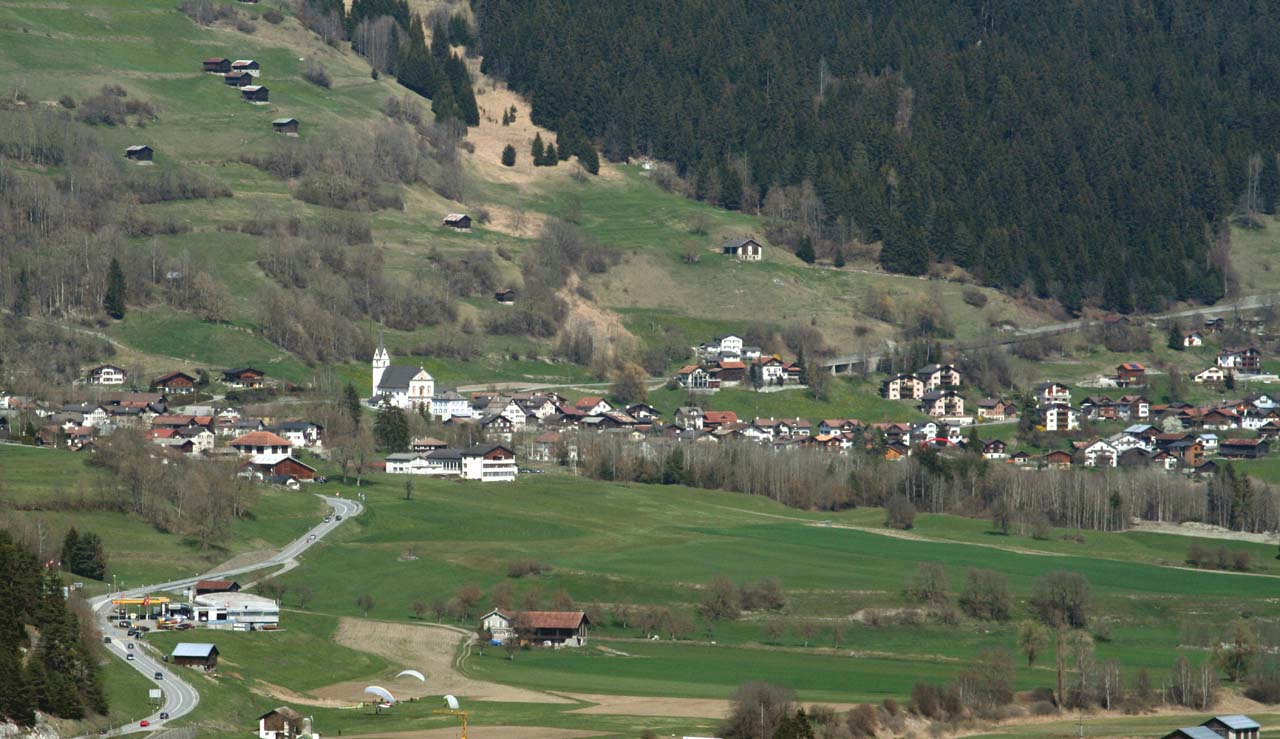|
Dominican Convent, Ilanz
The Dominican Convent, Ilanz, the motherhouse of the Congregation of the Ilanz Dominican Sisters (), is located on a low hillside across the valley from the little town, roughly 30 km (20 miles) to the west of Chur in the canton of Graubünden, Switzerland. The striking convent buildings date from the early 1970s, but the community traces its origins back to St. Joseph's Institute, founded with an educational remit at Ilanz in 1865. Today the sisters at Ilanz are the core element of an international community comprising around 160 sisters, members of one of a number of congregations of Ilanz Dominican Sisters operating from addresses in Switzerland, Germany and Austria. Outside Europe there is also one congregation in Brazil and another in Taiwan. History Early years The community recognises two founders, Johann Fidel Depuoz (1817-1875), born in Graubünden, and Babette Gasteyer (1835-1892), born far to the north, in Wiesbaden. Johann Fidel Depuoz became a Jesuit in ... [...More Info...] [...Related Items...] OR: [Wikipedia] [Google] [Baidu] |
Ilanz
Ilanz ( rm, Glion) is a former municipality in the district of Surselva in the Swiss canton of Graubünden. The former municipality of Ilanz was congruent with the town of Ilanz. On 1 January 1978, the former municipality of Strada merged into the new municipality of Ilanz. On 1 January 2014, the municipality of Ilanz and the surrounding municipalities Castrisch, Ladir, Luven, Pitasch, Riein, Ruschein, Schnaus, Sevgein, Duvin, Pigniu, Rueun and Siat merged into the new municipality of Ilanz/Glion. History Ilanz is first mentioned in 765 as "''Iliande''." Ilanz became the capital of the newly formed Grey League in 1395. The Grey League was the second of the Three Leagues which eventually formed canton Graubünden. Johannes von Ilanz, the Abbot of Disentis, was among the three nobles instrumental in creating this "eternal alliance." Ilanz has a special place in the history of the Protestant Reformation. In the 1520s, the Diet of Ilanz declared that citizens of the Three Leagues s ... [...More Info...] [...Related Items...] OR: [Wikipedia] [Google] [Baidu] |
Pope Pius IX
Pope Pius IX ( it, Pio IX, ''Pio Nono''; born Giovanni Maria Mastai Ferretti; 13 May 1792 – 7 February 1878) was head of the Catholic Church from 1846 to 1878, the longest verified papal reign. He was notable for convoking the First Vatican Council in 1868 and for permanently losing control of the Papal States in 1870 to the Kingdom of Italy. Thereafter he refused to leave Vatican City, declaring himself a " prisoner of the Vatican". At the time of his election, he was seen as a champion of liberalism and reform, but the Revolutions of 1848 decisively reversed his policies. Upon the assassination of his Prime Minister Rossi, Pius escaped Rome and excommunicated all participants in the short-lived Roman Republic. After its suppression by the French army and his return in 1850, his policies and doctrinal pronouncements became increasingly conservative, seeking to stem the revolutionary tide. In his 1849 encyclical '' Ubi primum'', he emphasized Mary's role in salvation. In 1 ... [...More Info...] [...Related Items...] OR: [Wikipedia] [Google] [Baidu] |
Zürich
Zürich () is the list of cities in Switzerland, largest city in Switzerland and the capital of the canton of Zürich. It is located in north-central Switzerland, at the northwestern tip of Lake Zürich. As of January 2020, the municipality has 434,335 inhabitants, the Urban agglomeration, urban area 1.315 million (2009), and the Zürich metropolitan area 1.83 million (2011). Zürich is a hub for railways, roads, and air traffic. Both Zurich Airport and Zürich Hauptbahnhof, Zürich's main railway station are the largest and busiest in the country. Permanently settled for over 2,000 years, Zürich was founded by the Roman Empire, Romans, who called it '. However, early settlements have been found dating back more than 6,400 years (although this only indicates human presence in the area and not the presence of a town that early). During the Middle Ages, Zürich gained the independent and privileged status of imperial immediacy and, in 1519, became a primary centre of the Protestant ... [...More Info...] [...Related Items...] OR: [Wikipedia] [Google] [Baidu] |
Davos
, neighboring_municipalities= Arosa, Bergün/Bravuogn, Klosters-Serneus, Langwies, S-chanf, Susch , twintowns = } Davos (, ; or ; rm, ; archaic it, Tavate) is an Alpine resort town and a municipality in the Prättigau/Davos Region in the canton of Graubünden, Switzerland. It has a permanent population of (). Davos is located on the river Landwasser, in the Rhaetian Alps, between the Plessur and Albula Ranges. The municipality covers nearly the entire valley of the Landwasser, and the centre of population, economic activity, and administration is two adjacent villages: Davos Dorf () and Davos Platz (''Davos'' ''Place''), at above sea level. Gaining prominence in the 19th century as a mountain health resort, Davos is perhaps best known today for hosting the World Economic Forum—often referred to simply as "Davos"—an annual meeting of global political and corporate leaders. With a long history of winter sport, Davos also has one of Switzerland's larg ... [...More Info...] [...Related Items...] OR: [Wikipedia] [Google] [Baidu] |
Trun, Switzerland
Trun is a municipality in the Surselva Region in the canton of Graubünden in Switzerland. The municipality of Schlans merged on 1 January 2012 into the municipality of Trun.Amtliches Gemeindeverzeichnis der Schweiz published by the Swiss Federal Statistical Office accessed 21 December 2011 History Trun is first mentioned in 765 as ''Tauronto''.Geography Trun has an area, , of . Of this area, 23.6% is used for agricultural purposes, while 34% is forested. Of the rest of the land, 1.9% is settled (buildings or roads) and the remainder (40.5%) is non-productive (rivers, glaciers or mountains). Following the 2012 merger, the new area was . Before 2017, the municipality was located i ...[...More Info...] [...Related Items...] OR: [Wikipedia] [Google] [Baidu] |
Catechesis
Catechesis (; from Greek: , "instruction by word of mouth", generally "instruction") is basic Christian religious education of children and adults, often from a catechism book. It started as education of converts to Christianity, but as the religion became institutionalized, catechesis was used for education of members who had been baptized as infants. As defined in the Catechism of the Catholic Church, paragraph 5 (quoting Pope John Paul II's Apostolic Exhortation '' Catechesi tradendae'', §18): ''Catechesis'' is an education in the faith of children, young people and adults which includes especially the teaching of Christian doctrine imparted, generally speaking, in an organic and systematic way, with a view to initiating the hearers into the fullness of Christian life.In the Catholic Church, catechist is a term used of anyone engaged in religious formation and education, from the bishop to lay ecclesial ministers and clergy to volunteers at the local level. The primary ... [...More Info...] [...Related Items...] OR: [Wikipedia] [Google] [Baidu] |
Caspar Decurtins
Caspar Decurtins (23 November 1855 – 30 May 1916) was a politician (Christian Democratic People's Party of Switzerland, Catholic-Conservative) from the Sursilvan dialects (Romansh), Surselva region, up-Vorderrhein (river), river to the west of Chur in the Switzerland, Swiss Cantons of Switzerland, canton of Grisons. He is regarded as a leading pioneer of the European :fr:Catholicisme social, Social Catholicism movement. Life Caspar Decurtins was born in Trun, Switzerland, Trun, a small village in the Sursilvan dialects (Romansh), Romansh speaking western part of Grisons, the canton. His father, Laurenz Christian Decurtins, was a physician and one of the local land owners. His mother, born Margaretha Katharina Latour, also came from a prominent family in the Vorderrhein (river), Vorderrhein (literally: ''"pre-Rhine"'') valley. The politician :de:Caspar de Latour, Caspar de Latour (1827-1861) was a paternal uncle. He attended Gymnasium (school), Gymnasium (secondary scho ... [...More Info...] [...Related Items...] OR: [Wikipedia] [Google] [Baidu] |
National Council (Switzerland)
The National Council (german: Nationalrat; french: Conseil national; it, Consiglio nazionale; rm, Cussegl naziunal) is the lower house of the Federal Assembly of Switzerland, the upper house being the Council of States. With 200 seats, the National Council is the larger of the two houses. Adult citizens elect the council's members, who are called National Councillors, for four year terms. These members are apportioned to the Swiss cantons in proportion to their population. Both houses meet in the Federal Palace of Switzerland in Bern. Organisation With 200 members, the National Council is the larger house of the Swiss legislature. When the Swiss federation was founded in 1848, the number of seats was not yet fixed, and was thus determined by the population of the individual cantons. According to the provisions of the federal constitution at that time, a canton was to receive one National Council member for every 20,000 citizens. Thus, the first National Council, which ... [...More Info...] [...Related Items...] OR: [Wikipedia] [Google] [Baidu] |
Dominican Order
The Order of Preachers ( la, Ordo Praedicatorum) abbreviated OP, also known as the Dominicans, is a Catholic mendicant order of Pontifical Right for men founded in Toulouse, France, by the Spanish priest, saint and mystic Dominic of Caleruega. It was approved by Pope Honorius III via the papal bull ''Religiosam vitam'' on 22 December 1216. Members of the order, who are referred to as ''Dominicans'', generally carry the letters ''OP'' after their names, standing for ''Ordinis Praedicatorum'', meaning ''of the Order of Preachers''. Membership in the order includes friars, nuns, active sisters, and lay or secular Dominicans (formerly known as tertiaries). More recently there has been a growing number of associates of the religious sisters who are unrelated to the tertiaries. Founded to preach the Gospel and to oppose heresy, the teaching activity of the order and its scholastic organisation placed the Preachers in the forefront of the intellectual life of the Middle Ag ... [...More Info...] [...Related Items...] OR: [Wikipedia] [Google] [Baidu] |
Religious Name
A religious name is a type of given name bestowed for a religious purposes, and which is generally used in such contexts. Christianity Catholic Church Baptismal name In baptism, Catholic Church, Catholics are given a Christian name, which should not be "foreign to Christian sentiment" and is often the name of a saint. In East Asia, in Africa and elsewhere, the baptismal name is distinct from the traditional-style given name. Traditionally, Orthodox and Catholic Christians celebrate their name day (i.e., the feast day of their patron saint), rather than their birthday. Confirmation name In some countries, it is common to adopt a Confirmation#Confirmation name, confirmation name, always the name of a saint, in addition to the baptismal name. The saint whose name is taken is henceforth considered to be a patron saint. Religious name In general, religious names are used among the persons of the consecrated life. In most religious institutes, a new member is traditionally either g ... [...More Info...] [...Related Items...] OR: [Wikipedia] [Google] [Baidu] |
Schluein
Schluein (; rm, Schleuis) is a municipality in the Surselva Region in the Swiss canton of Graubünden. History Schluein is first mentioned in 831 as ''Falerunae''. In 1298 it was mentioned as ''Sluwen''. Throughout the middle ages until the Act of Mediation, which ended the French controlled Helvetic Republic in 1803, Schluein was under the authority of the Herrschaft of the Löwenberg. The village church is first mentioned in 1321. Geography Schluein has an area, , of . Of this area, 29.9% is used for agricultural purposes, while 55.7% is forested. Of the rest of the land, 7.1% is settled (buildings or roads) and the remainder (7.3%) is non-productive (rivers, glaciers or mountains). Before 2017, the municipality was located in the Ilanz sub-district of the Surselva district on the left flank of the Gruob. It consists of the villages of Schluein, Casanova, and Fallerin. Until 1983 Schluein was known as Schleuis. [...More Info...] [...Related Items...] OR: [Wikipedia] [Google] [Baidu] |






